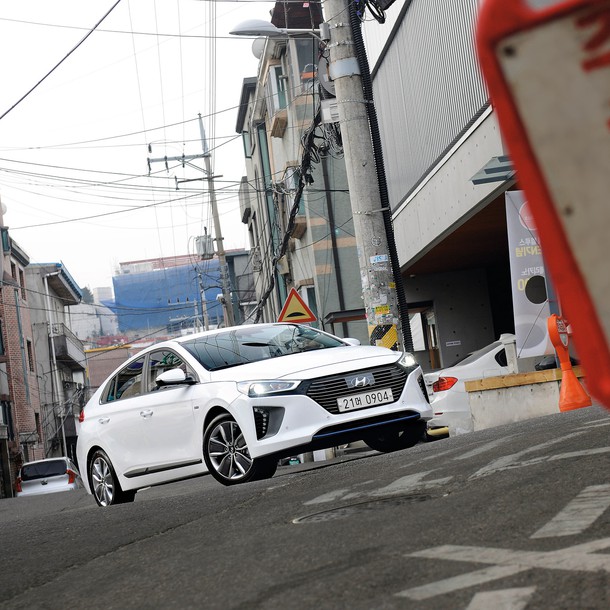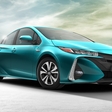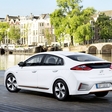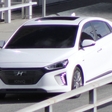
Hyundai is no longer a value brand, and has matured to become a direct Korean rival to VW. Now, in addition to increasing the overall quality of its products and global sales volume, the evolution also involves the creation of a new range of eco-friendly vehicles, of which the Ioniq Hybrid is the first specimen.
After the long-term project with fuel cell technology (a prototype of the iX35 SUV) and the shy Kia Optima Hybrid (available in just a few markets in its first generation), the 5th largest world automotive manufacturer ventures now into an eco-car offensive, of which the Ioniq is the first wave. The goal is to create a really wide range of models with low to zero emissions, which could comprise 20 vehicles by the end of this decade.

The plan is ambitious, but if we consider this first bold step, it is not hard to believe that it will become a reality. The Ioniq, whose world premiere took place at the Geneva Motor Show in early March, can be moved by no fewer than three different types of propulsion systems, with greater or lesser electrification: the Hybrid we drive here, a Plug-in Hybrid and a 100% electric version, all with the same platform, interior and technical base, and very few differences, other than the radiator grill, some interior highlights and the fact that the battery electric version uses a torsion bar connecting the rear wheels (rather than the more sophisticated multilink independent system of the other two versions). And yet, technically the three vehicles bear significant differences, in terms of powertrains: the hybrid Ioniq uses a 43.5 hp electric motor to assist the operation of the new 1.6 gas engine with Atkinson cycle, with direct injection and an output of 105 hp, and with which it is not possible to complete more than a couple of kilometers in purely electric mode. Plug-in electric version has a more powerful electric motor - you can learn more about them in our Geneva motorshow report.
At first glance, the exterior design is not far from what we know from the king of hybrids, the Toyota Prius, especially when viewed from the rear and in profile. Still, this 5-door and 5 occupant Hyundai looks more like a "normal" car, when observed from other angles, and its very low drag coefficient – of only 0.24 - confirms that the designers and the engineers teamed up to do a good job. Moreover, the fact that both the hood and the trunk cover, as well as various other suspension components, are made of aluminium, contributes to reduce the weight of the overall car, a sine qua non principle for any automobile with "eco" in its name.

Inside, both materials and the finish confirm Hyundai´s progress, even more so as the Ioniq´s dashboard looks and feels like the one from a serious car, even a non-hybrid car, far from some futuristic overboard executions (lacking in intuitive use), like the one that condemned the Opel Ampera to failure, for example. Noteworthy is the central color infotainment touch screen, and the new 7" high-resolution digital instrument panel, including all the relevant driving information, like specific data about the hybrid operation of the Ioniq. Depending on the selected drive mode, the display changes its design to provide the most important and useful information, and also to create a more relaxing or sportier ambiance, as determined by the driver.
After this first exclusive test in South Korea – even before the car´s first global public exposure in Geneva – we came back with little doubt as to the seriousness of the intentions of Hyundai in this electric offensive: "It will be a gradual but steady growth that will transform the image of our brand around the world," explained Woong Chul Yang, the project´s development chief. And this is something that can be seen if we look at the numbers: while Ioniq has an initial sales target of some 30,000 units in 2016, Toyota achieves that same volume of Prius sales in just one month. And even if we consider the 75,000 unit sales forecast for the whole Ioniq range in 2017, it becomes clear that it will take a few years before the Prius leadership feel threatened.

But the threat is real. Firstly, because the Hyundai-Kia empire continues to grow globally, with increasingly strong penetration in the United States, Europe and China. But also because, particularly in relation to the Ioniq, the tripartite bet has the undeniable merit of appealing to different users in different regions. Finally, this Ioniq Hybrid is more pleasant to drive than the Prius, mainly because it has a dual-clutch automatic transmission, and not a continuously variable gearbox, which Toyota stubbornly insists on using: the result is that, unlike the Prius, the Ioniq does not sound or feel like a washing machine when it accelerates. More than the maximum output of 141 hp and 265 Nm, we are convinced by the acceleration performance at any rpm, courtesy of the electric aid supplied to the gas engine, but also thanks to the direct injection (with a 200 bar injection pressure) and high compression ratio (due to Atkinson cycle) of this new 1.6 GDi unit. It achieves a 40% thermal efficiency, matching the record for series production cars with gas engines, which has just been set by the new Prius.

The driving impressions are also enhanced by the possibility to choose between Sport and Eco modes, the former holding out longer with no gear shifting, and the latter adjusting gear ratios to benefit fuel consumption. As it is normal with hybrids, regenerative braking allows you to send energy back to the battery and, with some practice, it is possible to drive in city traffic without stepping on the brake pedal, only using the deceleration generated by the regenerative braking. The 6-speed automatic dual-clutch transmission also features a sequential manual mode, so that driving a hybrid does not need to be a period of boredom behind the wheel.
The low position in which the battery is mounted helps the car´s handling through corners, a situation in which there is no sign of excessive body roll, even under more abrupt mass transfers, all this combined with a satisfactory level of overall ride comfort (even if, different from this South Korean test unit, the Ioniq bound for Europe will most likely have somewhat stiffer chassis tunings, to please the more demanding European drivers).

In addition to this qualitative analysis, in which the Hyundai clearly comes out on top of the Toyota, also in a quantitative evaluation the Ioniq (with its 141 ps) also challenges the world reference point among hybrid cars (the IV generation Prius offers 122 ps): 185 km/h maximum speed (the Toyota reaches 180 km/h), 8.2 s from 80-120 km/h (8.3) and 10.8 s from 0 to 100 km/h (10,6).
Exercising some caution with your right foot, you may reach a speed of 120 km/h in 100% electric mode, but it will not last long: there is no official number for the time being, but surely at this fast pace it will be unfeasible to complete more than a few hundred meters before the 1.56 kWh battery is empty. Yes the Ioniq uses lithium-ion (polymer) and not the lower energy density nickel-metal hydride chemistry of the Toyota Prius, but still you should not expect miracles.

The fanatics of especially efficient driving will likely most often use the Eco-Das system, which is able to analyze the overall conditions of the upcoming route set in the navigation system (type of road, traffic, etc.) and adapt battery energy delivery to what is ahead on the road, but still it is not foreseeable that the final average fuel consumption figure of the Ioniq Hybrid (3.4 l/100 km on the Korean homologation) will be better than the one from the new Prius (3.0 l/100 km).
As is traditional, the Korean brands want to do the same as the Japanese, but in much less time, even if it means arriving later. This Hybrid is the first of three eco Ioniq models that Hyundai will have on sale in Europe in the next 12 months: it offers a more intuitive and fun driving experience than the Prius, very similar performance, as well as balanced road handling, slightly higher fuel consumption, and an interior which accommodates 5 adults, in addition to showing a well thought-out execution and very reasonable quality.



